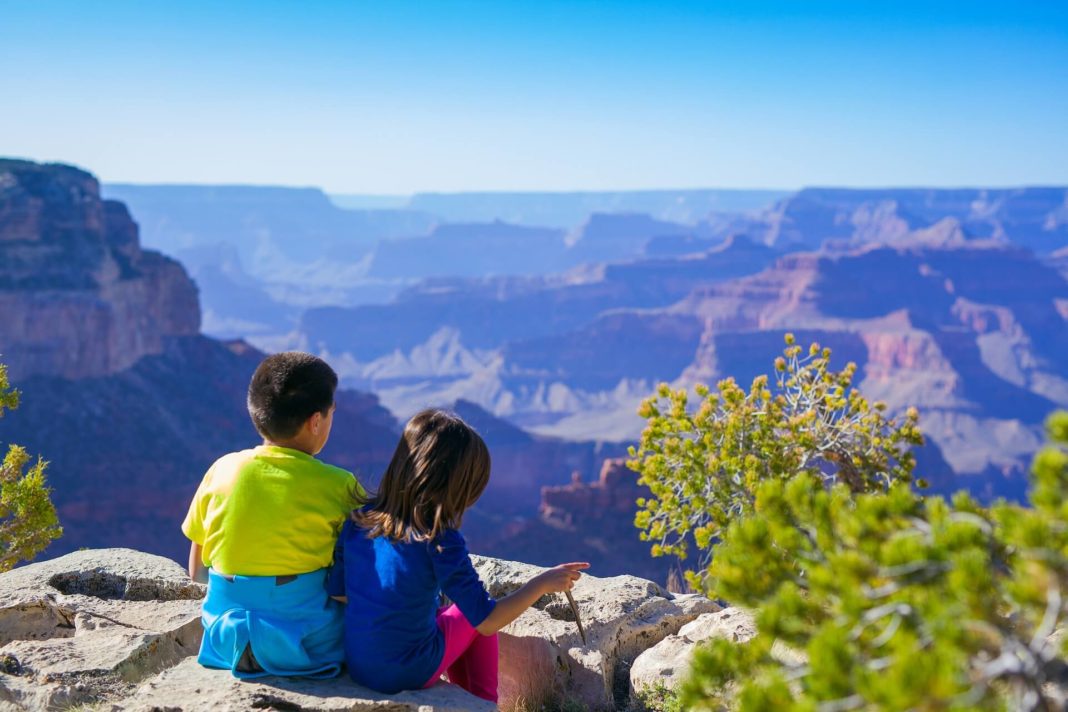The Grand Canyon is one of the most popular destinations in the United States. It’s located in southern Arizona and is more than 277 miles long. People from all over the world visit this canyon every year to experience its majestic beauty. The canyon has many different features, such as waterfalls, rock formations, and wide open spaces. There are also several trails that you can take to explore the canyon more. You can go hiking or horseback riding. If you want to see some of the most popular parts of the canyon, you can ride a helicopter to Angel’s Landing or hike Bright Angel Trail. You can also go camping at Phantom Ranch if you want to stay overnight. There are a lot of things to do at the Grand Canyon, so you will definitely find something that interests you.
Grand Canyon South Rim Attractions
The Grand Canyon South Rim is a breathtaking natural wonder located in Arizona, in the southwestern United States. It is one of the most popular tourist destinations in the country, and visitors can enjoy a variety of attractions and activities when visiting the South Rim of the canyon.
- Grand Canyon Village: The Grand Canyon Village is the main visitor center and the hub of all activities at the South Rim. It features numerous shops, restaurants, and museums, as well as access to various hiking trails and lookout points.
- Rim Trail: The Rim Trail is a beautiful trail that stretches along the South Rim, offering stunning views of the canyon and various lookout points. It is an easy and accessible trail, suitable for all ages and fitness levels.
- Bright Angel Trail: The Bright Angel Trail is a popular hiking trail that descends into the canyon, offering a challenging and rewarding experience. The trail is 12 miles round-trip and offers stunning views of the canyon and the Colorado River.
- Desert View Watchtower: The Desert View Watchtower is a historic watchtower located at the eastern end of the South Rim. It offers stunning views of the canyon and the surrounding landscape, as well as a museum and gift shop.
- Yavapai Geology Museum: The Yavapai Geology Museum is located near the South Rim, offering exhibits and displays on the geology and formation of the Grand Canyon.
- Mather Point: Mather Point is one of the most popular lookout points at the South Rim, offering stunning views of the canyon and various hiking trails.
- Tusayan Ruin and Museum: The Tusayan Ruin and Museum is located just outside the South Rim, offering exhibits and displays on the ancient Puebloan people who once inhabited the area.
Visitor Center
The Grand Canyon South Rim Visitor Center is the main hub for visitors to the South Rim of the Grand Canyon, located in Grand Canyon Village. The visitor center offers a wide range of services and facilities to help visitors plan and enjoy their visit to the Grand Canyon.
One of the primary functions of the South Rim Visitor Center is to provide information and resources to visitors. The center offers a variety of exhibits, maps, and brochures that explain the geology and natural history of the canyon, as well as the various activities and attractions available in the area. Visitors can also speak with knowledgeable staff and volunteers who can answer questions and provide recommendations on things to do and see.
The South Rim Visitor Center also features a large bookstore and gift shop, which offers a wide range of books, maps, and souvenirs related to the Grand Canyon and the surrounding area. The bookstore has an extensive collection of books on the canyon’s history, geology, and natural environment, as well as guides to hiking, camping, and other outdoor activities.
The visitor center also has several educational programs and exhibits, including interactive displays on the park’s flora and fauna, a theater showing short films about the canyon, and a display of Native American artifacts and cultural exhibits.
Another important feature of the South Rim Visitor Center is its transportation services. Visitors can take a free shuttle bus from the center to various locations throughout the park, including popular lookout points and hiking trails. The shuttle service runs regularly throughout the day and provides an easy and convenient way for visitors to get around the park.
Mather Point Overlook
Mather Point is one of the most popular and well-known overlooks at the Grand Canyon South Rim, offering breathtaking views of the canyon and its surrounding landscapes. The overlook is located near the Grand Canyon Village and is easily accessible by car or shuttle bus.
Mather Point offers a panoramic view of the canyon, with stunning vistas of the Colorado River, Bright Angel Canyon, and Phantom Ranch. The overlook is located at an elevation of over 7,000 feet, providing a stunning vantage point to appreciate the vastness and beauty of the canyon.
Visitors can enjoy the view from several different vantage points at Mather Point, including the main overlook, a lower platform, and a wheelchair-accessible ramp. The overlook also features several interpretive displays and signs that explain the geology and natural history of the Grand Canyon.
Mather Point is a popular destination for photographers, who come to capture the stunning sunrises and sunsets over the canyon. The overlook is open year-round, and visitors can enjoy different views depending on the time of day and season.
In addition to the stunning views, Mather Point also offers access to several hiking trails and other attractions. Visitors can take the Bright Angel Trail or South Kaibab Trail down into the canyon, or explore nearby museums and cultural exhibits in the Grand Canyon Village.
South Rim Trail
The South Rim Trail is a beautiful and accessible hiking trail that stretches along the South Rim of the Grand Canyon. The trail offers stunning views of the canyon and its surrounding landscapes and is suitable for visitors of all ages and fitness levels.
The South Rim Trail runs for approximately 13 miles from the South Kaibab Trailhead to Hermit’s Rest, with several lookout points and facilities along the way. The trail is mostly paved and is wheelchair-accessible in many sections, making it a popular choice for visitors who want to experience the beauty of the canyon without embarking on a strenuous hike.
Along the South Rim Trail, visitors can enjoy stunning vistas of the canyon, with panoramic views of the Bright Angel Canyon, Phantom Ranch, and the Colorado River. The trail also offers access to several historic buildings and cultural exhibits, including the Grand Canyon Village and the Desert View Watchtower.
In addition to its stunning views and cultural attractions, the South Rim Trail also offers access to several hiking trails and backcountry campsites. Visitors can take the Bright Angel Trail or South Kaibab Trail down into the canyon, or explore nearby attractions such as the Tusayan Ruin and Museum and the Yavapai Geology Museum.
The South Rim Trail is open year-round and offers different experiences depending on the time of day and season. Visitors are encouraged to bring plenty of water and sunscreen, and to dress in layers to accommodate the changing weather and temperatures.
the Canyon Geological Museum
The Yavapai Geology Museum, also known as the Canyon Geological Museum, is a fascinating museum located on the South Rim of the Grand Canyon in Arizona, USA. The museum offers exhibits and displays that showcase the geology and natural history of the Grand Canyon, providing visitors with a deeper understanding and appreciation of this awe-inspiring natural wonder.
The museum features several exhibits and displays that highlight the geology and formation of the Grand Canyon, including interactive displays, models, and multimedia presentations. Visitors can learn about the various rock layers and formations that make up the canyon, as well as the natural forces that shaped the landscape over millions of years.
The museum also offers a variety of interpretive displays that explain the flora and fauna of the canyon, as well as the cultural history of the area. Visitors can learn about the various Native American tribes that have inhabited the area, as well as the early explorers and pioneers who helped to shape the region.
One of the highlights of the Yavapai Geology Museum is its panoramic viewing area, which offers stunning views of the canyon and its surrounding landscapes. Visitors can take in the view while learning about the geological processes that created the stunning rock formations and towering cliffs.
The museum is open year-round and is free to visitors. It is located near the South Rim Village and is easily accessible by shuttle bus or car. Overall, the Yavapai Geology Museum is a must-visit destination for anyone interested in the geology and natural history of the Grand Canyon, offering a fascinating and educational experience for visitors of all ages.
Hermit Road Drive
The Hermit Road Drive is a scenic drive that stretches for 7 miles along the South Rim of the Grand Canyon, offering stunning views of the canyon and its surrounding landscapes. The road is only open to private vehicles during the off-season (late November through late February), but is otherwise accessible only by free shuttle bus.
The drive begins at the Grand Canyon Village and ends at Hermit’s Rest, a historic structure designed by Mary Colter and built in 1914. The building was originally intended to serve as a rest area and gift shop for tourists visiting the area, and it is now listed on the National Register of Historic Places.
Along the Hermit Road Drive, visitors can enjoy panoramic views of the canyon, with numerous lookout points and vistas that offer stunning vistas of the Bright Angel Canyon, Phantom Ranch, and the Colorado River. The road is relatively flat and paved, making it accessible to most visitors, including those with strollers and wheelchairs.
In addition to the stunning views, the Hermit Road Drive also offers access to several hiking trails and backcountry campsites, including the popular Hermit Trail and Dripping Springs Trail. Visitors can also explore nearby cultural attractions, such as the Tusayan Ruin and Museum and the Yavapai Geology Museum.
Bright Angel Hiking Trail
The Bright Angel Trail is one of the most popular and iconic hiking trails at the Grand Canyon South Rim in Arizona, USA. The trail is approximately 9.3 miles long, round-trip, and descends into the canyon to a point called the Colorado River.
The trail begins at the South Rim and descends steeply through a series of switchbacks, offering stunning views of the canyon and its surrounding landscapes. Hikers can choose to hike the entire trail or turn back at various points along the way, depending on their skill level and fitness.
The trail offers several rest areas and water stations along the way, as well as emergency phones in case of injury or other emergencies. Hikers are advised to bring plenty of water and snacks, as well as sturdy hiking boots and appropriate clothing to accommodate the changing temperatures and weather conditions.
The Bright Angel Trail is a popular destination for hikers and backpackers, and backcountry permits are required for overnight stays. The trail offers access to several backcountry campsites, including Indian Garden and Bright Angel Campground, which provide opportunities for exploring the inner canyon and experiencing the natural beauty of the area.
Desert View Drive
Desert View Drive is a scenic drive that stretches for 25 miles along the South Rim of the Grand Canyon in Arizona, USA. The drive begins at the Grand Canyon Village and ends at the Desert View Watchtower, offering stunning views of the canyon and its surrounding landscapes.
The drive features several lookout points and vistas, including the Moran Point, Lipan Point, and the Desert View Watchtower. Each lookout point provides a unique perspective of the canyon, with panoramic views of the Colorado River, Bright Angel Canyon, and the Phantom Ranch.
Along the drive, visitors can also explore several hiking trails, including the Rim Trail and the Tanner Trail, which offer opportunities for exploring the inner canyon and experiencing the natural beauty of the area. Visitors can also enjoy picnicking and other outdoor activities at several designated picnic areas and overlooks.
Desert View Drive is open year-round and is easily accessible by shuttle bus or car. The drive is a must-visit destination for anyone traveling to the Grand Canyon South Rim, offering breathtaking views and easy access to some of the park’s most iconic attractions.
Desert View Watchtower
The Desert View Watchtower is a historic structure located at the eastern end of the Grand Canyon South Rim in Arizona, USA. The tower was designed by Mary Colter, a renowned architect and designer who worked for the Fred Harvey Company, which was responsible for many of the early tourism developments at the Grand Canyon.
Built in 1932, the Desert View Watchtower was intended to serve as a rest area and gift shop for tourists visiting the area. Today, the tower is a popular attraction for visitors to the Grand Canyon, offering stunning views of the canyon and surrounding landscapes, as well as exhibits and displays that explain the history and culture of the area.
The tower is designed to resemble an ancient Native American watchtower, with a circular shape and rustic stonework. Inside, visitors can climb the spiral staircase to several levels, each offering unique and breathtaking views of the canyon and surrounding landscapes. The tower also features several murals and other artworks, including paintings by Hopi artist Fred Kabotie.
In addition to its stunning views, the Desert View Watchtower offers access to several hiking trails and backcountry campsites, including the popular Tanner Trail and the Horseshoe Mesa. Visitors can also explore nearby cultural attractions, such as the Tusayan Ruin and Museum and the Yavapai Geology Museum.
The Desert View Watchtower is open year-round and is easily accessible by shuttle bus or car. It is a must-visit destination for anyone interested in history, culture, or stunning natural beauty, and provides a unique and memorable experience for visitors to the Grand Canyon.
Lookout Studio
The Lookout Studio is a historic structure located on the Grand Canyon South Rim in Arizona, USA. The studio was designed by Mary Colter, a renowned architect and designer who worked for the Fred Harvey Company, which was responsible for many of the early tourism developments at the Grand Canyon.
Built in 1914, the Lookout Studio was intended to serve as a rest area and gift shop for tourists visiting the area. Today, the studio is a popular attraction for visitors to the Grand Canyon, offering stunning views of the canyon and surrounding landscapes, as well as exhibits and displays that explain the history and culture of the area.
The Lookout Studio is designed to resemble a natural rock formation, with a rustic stone exterior and panoramic windows that offer breathtaking views of the canyon. Inside, visitors can explore several levels of exhibits and displays, including photographs, artwork, and artifacts related to the history and culture of the Grand Canyon.
In addition to its cultural and historical attractions, the Lookout Studio also offers access to several hiking trails and backcountry campsites, including the popular Bright Angel Trail and the South Kaibab Trail. Visitors can also explore nearby cultural attractions, such as the Tusayan Ruin and Museum and the Yavapai Geology Museum.
The Lookout Studio is open year-round and is easily accessible by shuttle bus or car. It is a must-visit destination for anyone interested in history, culture, or stunning natural beauty, and provides a unique and memorable experience for visitors to the Grand Canyon.
Kolb Gallery
The Kolb Studio is a historic structure located on the Grand Canyon South Rim in Arizona, USA. The studio was designed by brothers Ellsworth and Emery Kolb, who were pioneering photographers and filmmakers in the early 20th century, known for their stunning photographs and films of the Grand Canyon.
Built in 1904, the Kolb Studio served as the brothers’ home and studio, as well as a popular attraction for tourists visiting the area. Today, the studio is a museum and cultural center, offering exhibits and displays that showcase the history and culture of the Grand Canyon, as well as the Kolb brothers’ pioneering photography and filmmaking.
Visitors to the Kolb Studio can explore several levels of exhibits and displays, including photographs, films, and artifacts related to the history and culture of the Grand Canyon, as well as the Kolb brothers’ pioneering work. The studio also features a theater showing films related to the Grand Canyon and the Kolb brothers’ work.
In addition to its cultural and historical attractions, the Kolb Studio also offers access to several hiking trails and backcountry campsites, including the popular Bright Angel Trail and the South Kaibab Trail. Visitors can also explore nearby cultural attractions, such as the Tusayan Ruin and Museum and the Yavapai Geology Museum.
The Kolb Studio is open year-round and is easily accessible by shuttle bus or car. It is a must-visit destination for anyone interested in history, culture, or stunning natural beauty, and provides a unique and memorable experience for visitors to the Grand Canyon.
Little Colorado River Overlook
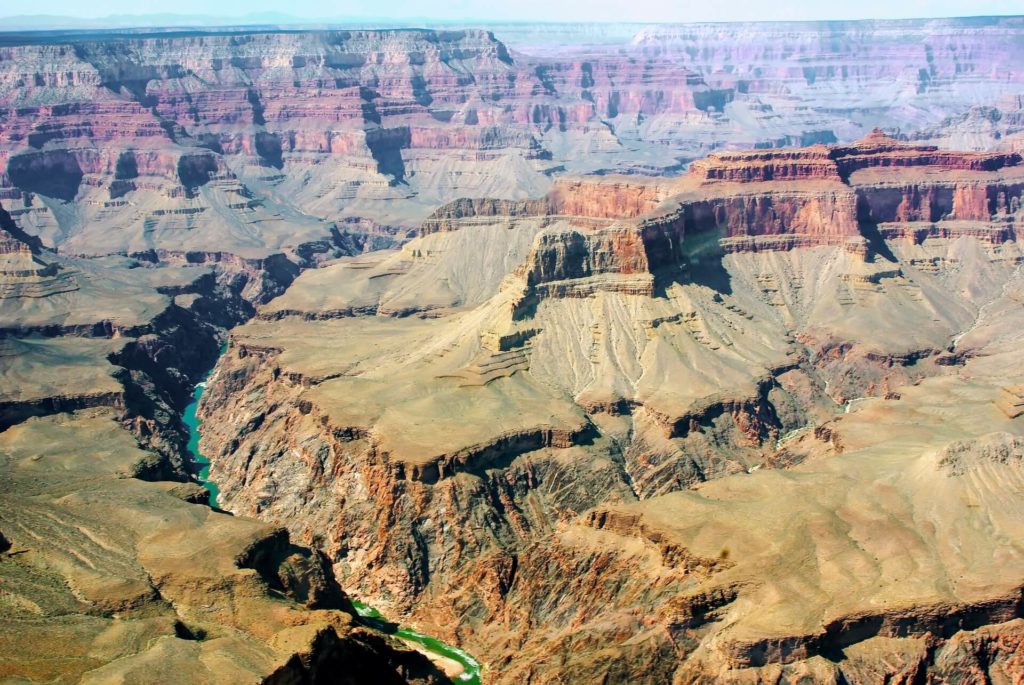
The Little Colorado River Overlook is a scenic overlook located on the eastern end of the Grand Canyon South Rim in Arizona, USA. The overlook offers stunning views of the Little Colorado River Gorge, a deep and narrow canyon that runs through the desert landscape.
The overlook is located on Navajo land, and visitors can purchase a permit to access the area. The permit is required and can be purchased at the overlook or online. The area is considered sacred by the Navajo Nation, and visitors are asked to respect the land and the culture of the people who call it home.
The overlook features a large viewing platform that offers panoramic views of the Little Colorado River Gorge and the surrounding landscapes. Visitors can take in the stunning vistas of the canyon, with its colorful rock formations and rugged terrain.
The Little Colorado River Overlook is located in a remote and sparsely populated area, and visitors are advised to bring plenty of water and snacks, as well as sturdy shoes and appropriate clothing to accommodate the changing temperatures and weather conditions. The area is also prone to flash floods, and visitors are advised to be aware of weather conditions and to stay alert at all times.
Grand Canyon West Rim Attractions
The Grand Canyon West Rim is a popular destination for visitors to the Grand Canyon in Arizona, USA. While not part of the national park, the West Rim is managed by the Hualapai Tribe and offers several unique and exciting attractions and activities for visitors to enjoy.
Here are some of the top attractions and activities at the Grand Canyon West Rim:
- Skywalk: The Skywalk is a glass walkway that extends 70 feet over the edge of the canyon, offering stunning views of the Colorado River and the surrounding landscapes. Visitors can walk on the transparent bridge, which is suspended 4,000 feet above the canyon floor.
- Helicopter tours: Visitors can take helicopter tours of the canyon, offering aerial views of the West Rim, Hoover Dam, and Lake Mead. The helicopter tours provide a unique and thrilling perspective of the canyon and its surroundings.
- Zip line: Visitors can ride a zip line over the canyon, offering a unique and exciting way to experience the natural beauty of the area.
- Guano Point: Guano Point is a scenic overlook that offers stunning views of the canyon and its surrounding landscapes. Visitors can hike to the top of the point for even more breathtaking views.
- Hualapai Ranch: The Hualapai Ranch offers a Western-themed experience, with horseback riding, cowboy shows, and other activities that celebrate the culture and history of the area.
Skywalk
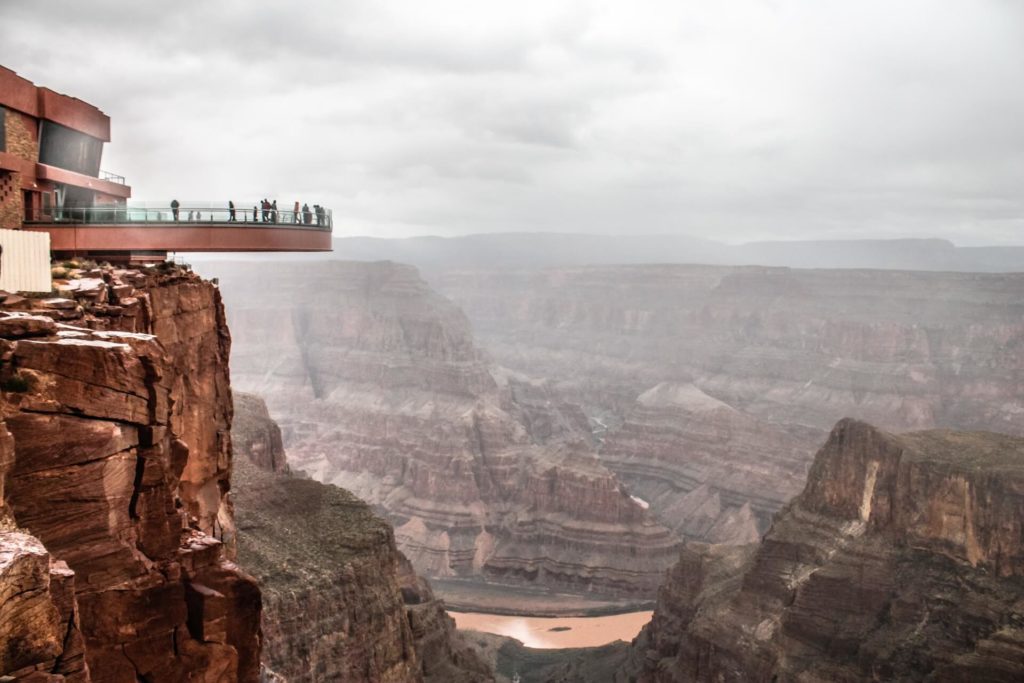
The Skywalk is a horseshoe-shaped glass bridge that extends 70 feet over the Grand Canyon West Rim in Arizona, USA. The bridge is located on the Hualapai Indian Reservation, and is managed by the Hualapai Tribe.
The Skywalk is a popular attraction for visitors to the Grand Canyon, offering stunning views of the canyon and its surrounding landscapes. The bridge is made of glass panels that are four inches thick and can support up to 71 million pounds of weight. Visitors can walk on the transparent bridge, which is suspended 4,000 feet above the canyon floor, and experience the thrill of walking on air.
In addition to the Skywalk itself, visitors can also enjoy other attractions and activities at the Grand Canyon West Rim, including helicopter tours, zip lining, and cultural experiences that celebrate the history and culture of the Hualapai people.
The Skywalk is open year-round, and tickets can be purchased at the Skywalk or online. Visitors are advised to wear appropriate footwear and clothing, and to store all loose items, including cameras and phones, in provided lockers before stepping onto the bridge. Photography is not allowed on the Skywalk itself, but visitors can purchase photos taken by professional photographers on the bridge.
Eagle Point
Eagle Point is a scenic overlook located on the Grand Canyon West Rim in Arizona, USA. The overlook is managed by the Hualapai Tribe, and offers stunning views of the canyon and its surrounding landscapes.
One of the highlights of Eagle Point is the rock formation known as the Eagle, which is shaped like an eagle in flight. Visitors can walk out onto the Eagle Point, which offers a unique and breathtaking perspective of the canyon and its rugged terrain.
In addition to its stunning views, Eagle Point also offers several attractions and activities for visitors to enjoy, including the Skywalk, a glass walkway that extends 70 feet over the canyon, offering stunning views of the Colorado River and the surrounding landscapes.
Visitors can also enjoy cultural experiences at Eagle Point, including performances by Native American dancers and musicians, as well as exhibits and displays that celebrate the history and culture of the Hualapai people.
Eagle Point is open year-round, and tickets can be purchased at the site or online. Visitors are advised to wear appropriate footwear and clothing, and to bring plenty of water and snacks, as well as to store all loose items in provided lockers before stepping onto the Skywalk. Photography is not allowed on the Skywalk itself, but visitors can purchase photos taken by professional photographers on the bridge.
Grand Canyon Tours
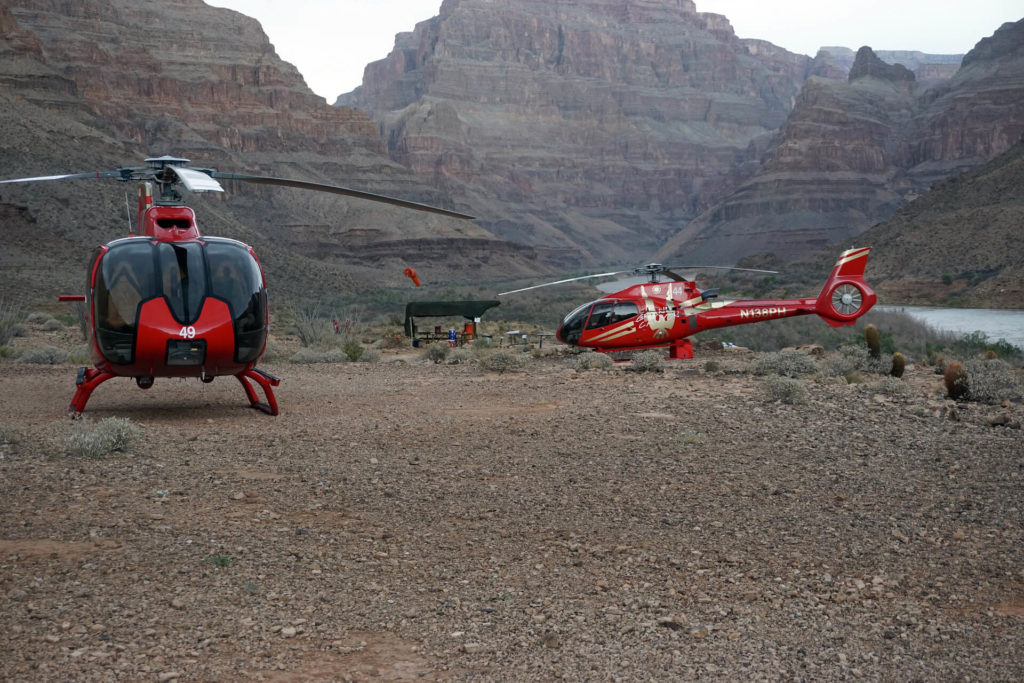
Take a 25-minute Grand Canyon Helicopter Tour to get a bird’s-eye view of the Grand Canyon’s impressive beauty. To reach the South Entrance of the park, tourists only need to get into their vehicles and drive for less than 10 minutes from the Grand Canyon Airport. With this flight, you will soar above the vast and magnificent Dragon Corridor, plus several other critical sights.
Grand Canyon White Water Rafting Trip from Las Vegas
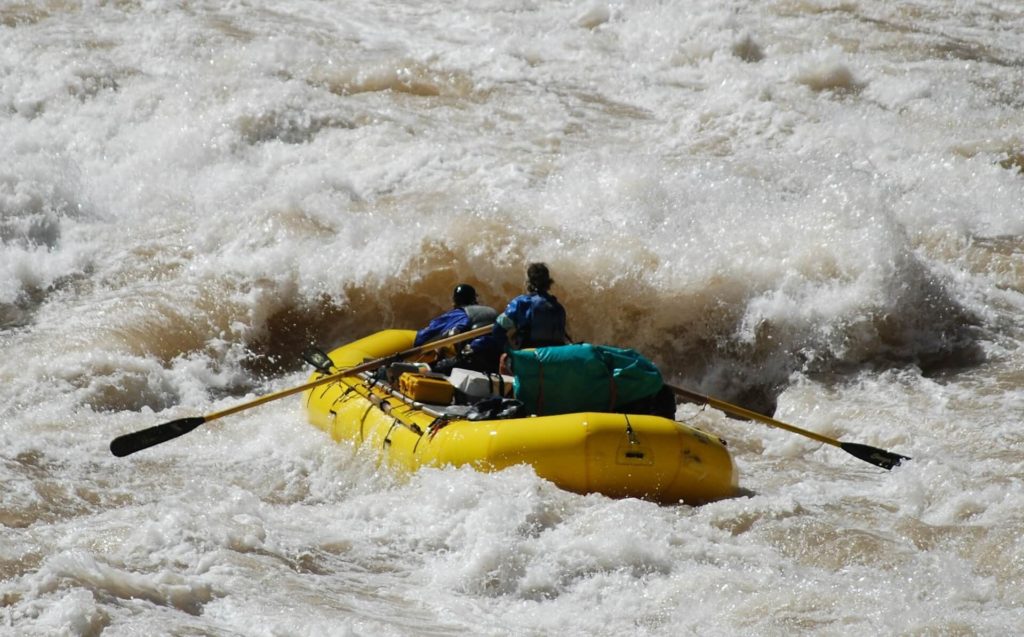
On a one-day white water rafting trip starting from Las Vegas, raft 40 miles down the Colorado River. This trip starts at 4:00 A.M. and will take approximately 15 hours, with one night of hotel accommodations, a van ride, a short helicopter flight, a full day of white water rafting on the Colorado River, and a return trip to Las Vegas.
South Rim Mule Rides
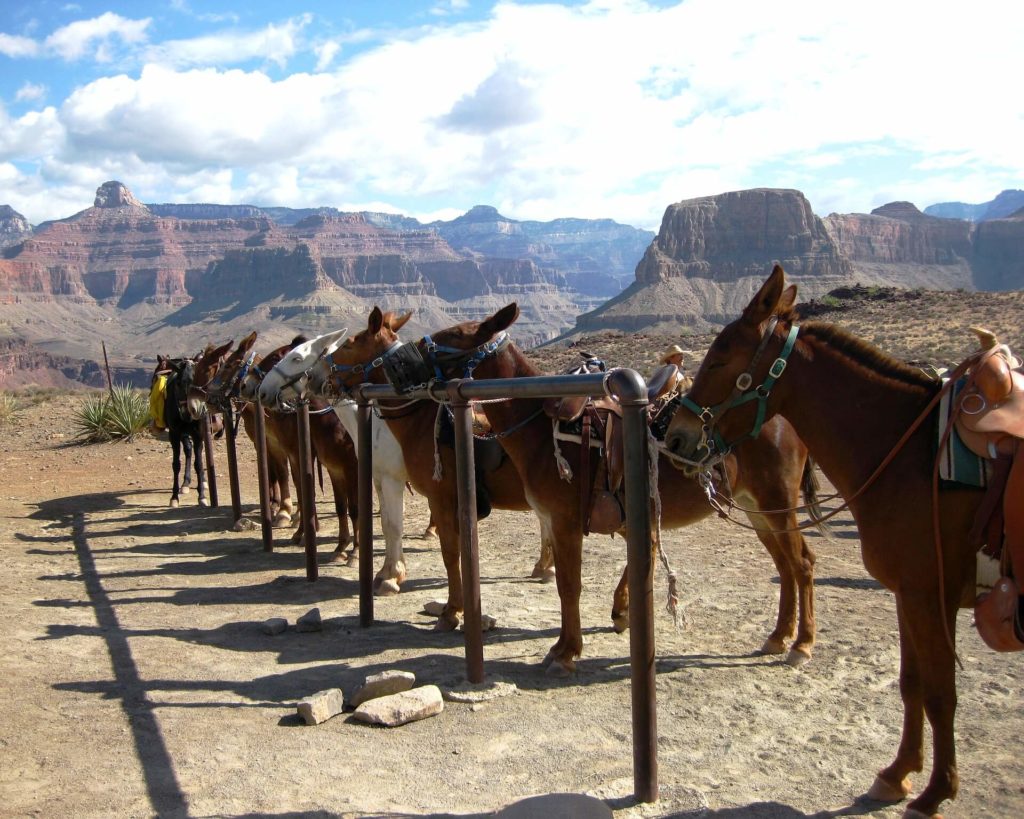
The Grand Canyon south rim mule ride is one of the most popular ways to experience the Grand Canyon. This ride takes you on a scenic journey through the canyon where you can hike, view the canyon’s stunning vistas, and take in beautiful views of the canyon. The mule ride is a unique way to experience the Grand Canyon because it allows visitors to hike alongside their guide. Hiking through the canyon is an exciting adventure that will leave you with lasting memories.
You can book your mule ride at any of the park’s visitor centers or by contacting Xanterra Parks & Resorts directly. The mule rides are offered during all seasons, but they tend to be busiest during spring and summer months as visitors flock to see this iconic landscape.
Best Grand Canyon Scenic Points
Grandview Point
Grandview Point is a scenic overlook located on the Grand Canyon South Rim in Arizona, USA. The point is located at an elevation of 7,400 feet, and offers stunning views of the canyon and its surrounding landscapes.
Grandview Point is one of the most popular and iconic viewpoints on the South Rim, offering panoramic views of the canyon and the Colorado River. Visitors can take in the breathtaking vistas, with its colorful rock formations and rugged terrain, and experience the natural beauty of the area.
In addition to its stunning views, Grandview Point also offers access to several hiking trails, including the popular Grandview Trail, which descends into the canyon and offers opportunities for exploring the inner canyon and experiencing the natural beauty of the area. Visitors can also enjoy picnicking and other outdoor activities at several designated picnic areas and overlooks.
Grandview Point is open year-round and is easily accessible by shuttle bus or car. The area is also prone to weather changes, and visitors are advised to bring plenty of water and snacks, as well as sturdy shoes and appropriate clothing to accommodate the changing temperatures and weather conditions.
Yaki Point
Yaki Point is a scenic overlook located on the Grand Canyon South Rim in Arizona, USA. The point is located at an elevation of 7,000 feet, and offers stunning views of the canyon and its surrounding landscapes.
Yaki Point is a popular and picturesque viewpoint on the South Rim, offering panoramic views of the canyon and the Colorado River. Visitors can take in the breathtaking vistas, with its colorful rock formations and rugged terrain, and experience the natural beauty of the area.
In addition to its stunning views, Yaki Point also offers access to several hiking trails, including the popular South Kaibab Trail, which descends into the canyon and offers opportunities for exploring the inner canyon and experiencing the natural beauty of the area. Visitors can also enjoy picnicking and other outdoor activities at several designated picnic areas and overlooks.
Yaki Point is open year-round and is easily accessible by shuttle bus or car. The area is also prone to weather changes, and visitors are advised to bring plenty of water and snacks, as well as sturdy shoes and appropriate clothing to accommodate the changing temperatures and weather conditions.
It is important to note that Yaki Point is currently closed to private vehicles, and can only be accessed by the park shuttle bus or through private commercial tours. This is part of the park’s efforts to reduce traffic and improve air quality.
Lookout Studio
The Lookout Studio is a historic structure located on the Grand Canyon South Rim in Arizona, USA. Designed by renowned architect and designer Mary Colter in 1914, the studio served as a rest area and gift shop for early tourists visiting the area. Today, it is a museum and cultural center, offering exhibits and displays that showcase the history and culture of the Grand Canyon, as well as the Kolb brothers’ pioneering photography and filmmaking. The studio’s rustic stone exterior and panoramic windows offer breathtaking views of the canyon, making it a popular destination for visitors to the Grand Canyon.
Yavapai Point
Yavapai Point is a scenic overlook located on the Grand Canyon South Rim in Arizona, USA. The point is named after the Yavapai people, who are native to the area. Yavapai Point offers breathtaking views of the canyon and its surrounding landscapes, and is known for its panoramic vistas and stunning sunsets. Visitors can also explore the Yavapai Geology Museum, located nearby, which features exhibits and displays that explain the geological history of the Grand Canyon. The museum is a popular destination for visitors interested in learning about the natural history of the area. Yavapai Point is easily accessible by shuttle bus or car, and is a must-visit destination for anyone interested in experiencing the natural beauty of the Grand Canyon.
Mather Point
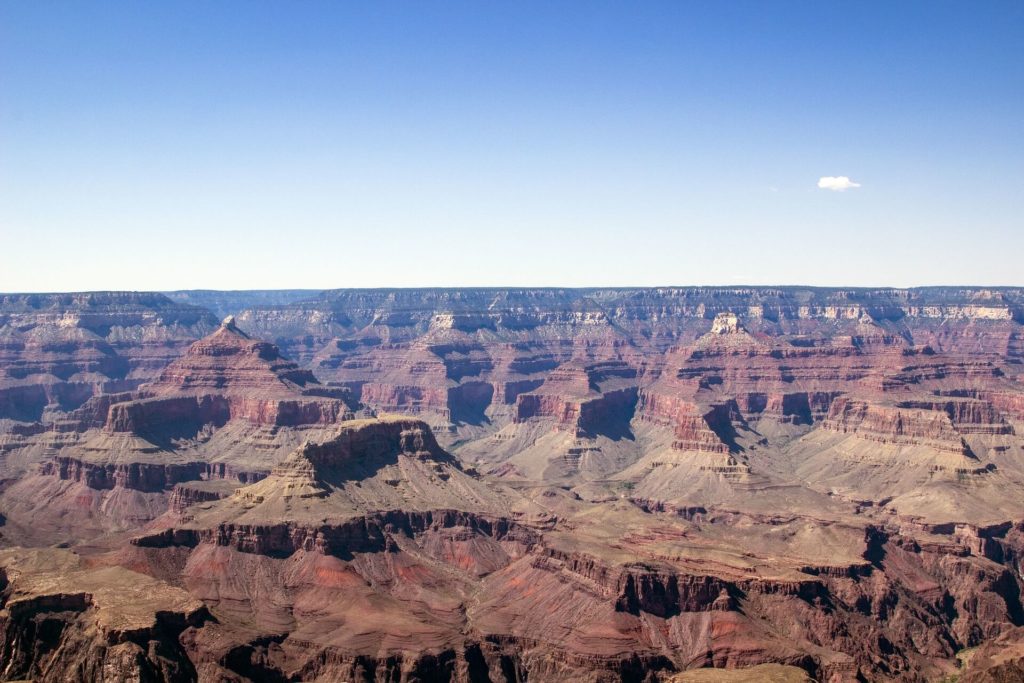
Vishnu Temple and Temple of Zoroaster, which are separated by a vast distance on the southern rim, are able to offer up-close and uninterrupted views of these conspicuous pinnacles. This lookout looks out over the western half of the Grand Canyon, giving you an excellent view of sunsets.
Moran Point
Moran Point is a scenic overlook located on the Grand Canyon South Rim in Arizona, USA. The point is named after Thomas Moran, an American painter who is known for his stunning paintings of the American West, including the Grand Canyon.
Moran Point offers panoramic views of the canyon and its surrounding landscapes, and is known for its striking rock formations and rugged terrain. Visitors can take in the breathtaking vistas and experience the natural beauty of the area.
In addition to its stunning views, Moran Point also offers access to several hiking trails, including the popular Tonto Trail, which runs along the South Rim and offers opportunities for exploring the inner canyon and experiencing the natural beauty of the area. Visitors can also enjoy picnicking and other outdoor activities at several designated picnic areas and overlooks.
Moran Point is open year-round and is easily accessible by shuttle bus or car. The area is also prone to weather changes, and visitors are advised to bring plenty of water and snacks, as well as sturdy shoes and appropriate clothing to accommodate the changing temperatures and weather conditions.
Desert View and Watchtower
Desert View is a scenic overlook located on the Grand Canyon South Rim in Arizona, USA. It is the easternmost point on the South Rim and offers panoramic views of the canyon and its surrounding landscapes. Desert View is also home to the Desert View Watchtower, a historic structure designed by renowned architect Mary Colter in 1932.
The Desert View Watchtower is a five-story structure that was modeled after ancient Native American watchtowers, and offers stunning views of the canyon and its surrounding landscapes from its observation deck. The tower features murals and other artwork by Hopi artist Fred Kabotie, as well as exhibits and displays that explain the history and culture of the area.
Vermilion Cliffs – Marble Canyon
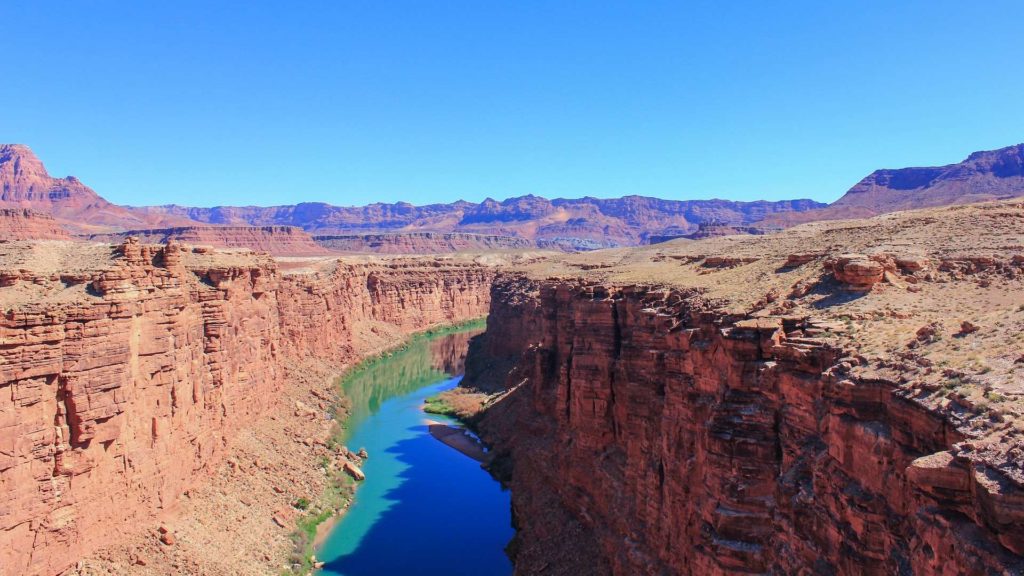
Vermilion Cliffs National Monument is a protected area located in northern Arizona, USA. The monument includes a vast and colorful landscape that includes towering sandstone cliffs, deep canyons, and other unique geological formations.
One of the highlights of the monument is Marble Canyon, a spectacular canyon that is located on the eastern boundary of the monument. The canyon is named for its colorful and smooth marble walls, which are unique in the area.
Visitors to Marble Canyon can enjoy hiking, rafting, and other outdoor activities, as well as explore the natural and cultural history of the area. The canyon is also home to several species of wildlife, including bald eagles, bighorn sheep, and mountain lions, making it a popular destination for wildlife viewing.
The monument is managed by the Bureau of Land Management, and visitors are advised to obtain current information about road and weather conditions, as well as any necessary permits, before visiting. Overall, Vermilion Cliffs National Monument and Marble Canyon are must-visit destinations for anyone interested in experiencing the natural beauty and cultural significance of the American Southwest.
Point Imperial
Point Imperial is a scenic overlook located on the Grand Canyon North Rim in Arizona, USA. The point is the highest overlook on the North Rim, at an elevation of over 8,800 feet, and offers stunning views of the canyon and its surrounding landscapes.
Point Imperial is known for its panoramic vistas and stunning sunsets, which make it a popular destination for visitors to the Grand Canyon. The overlook offers views of the eastern portion of the canyon, as well as the Painted Desert and the Vermilion Cliffs in the distance.
In addition to its stunning views, Point Imperial also offers access to several hiking trails, including the popular North Kaibab Trail, which descends into the canyon and offers opportunities for exploring the inner canyon and experiencing the natural beauty of the area. Visitors can also enjoy picnicking and other outdoor activities at several designated picnic areas and overlooks.
Point Imperial is open from mid-May to mid-October, weather permitting, and is easily accessible by car. The North Rim is less crowded than the South Rim and offers a quieter and more secluded experience for visitors to the Grand Canyon.
Lipan Point
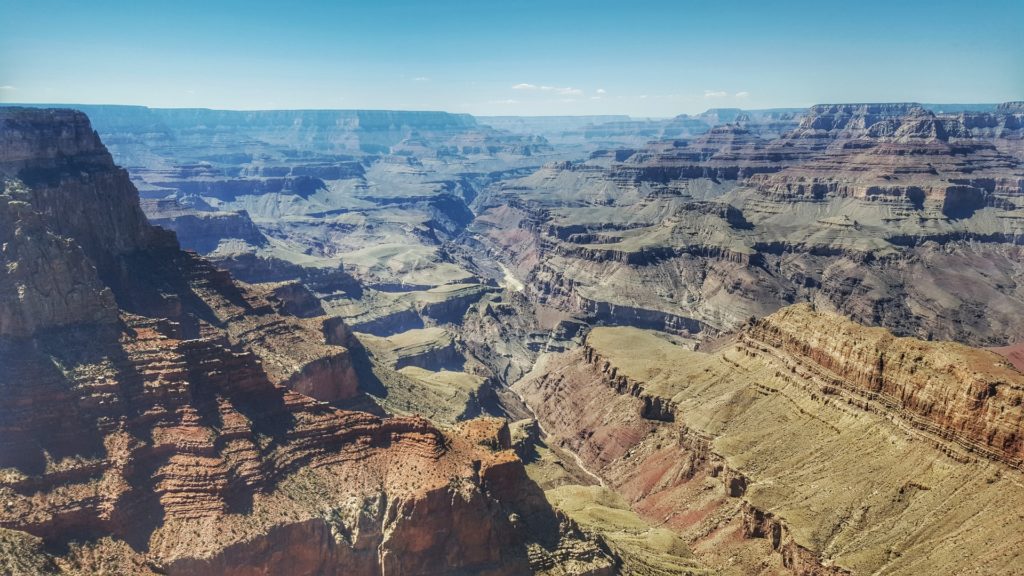
Lipan Point is a scenic overlook located on the Grand Canyon South Rim in Arizona, USA. The point offers stunning views of the canyon and its surrounding landscapes, and is known for its panoramic vistas and stunning sunsets.
Lipan Point is located on the eastern end of the South Rim and offers views of the eastern portion of the canyon, including the Painted Desert and the Navajo Mountain in the distance. The overlook is also known for its striking rock formations and rugged terrain.
In addition to its stunning views, Lipan Point also offers access to several hiking trails, including the popular South Kaibab Trail, which descends into the canyon and offers opportunities for exploring the inner canyon and experiencing the natural beauty of the area. Visitors can also enjoy picnicking and other outdoor activities at several designated picnic areas and overlooks.
Lipan Point is open year-round and is easily accessible by shuttle bus or car. The area is also prone to weather changes, and visitors are advised to bring plenty of water and snacks, as well as sturdy shoes and appropriate clothing to accommodate the changing temperatures and weather conditions..
FAQ about Grand Canyon
Where is the Grand Canyon?
Grand Canyon is located in Arizona's northwest region, near the Utah and Nevada state borders. Although the Colorado River, which flows down the canyon, drains water from seven states, the Grand Canyon is wholly inside the state of Arizona.





